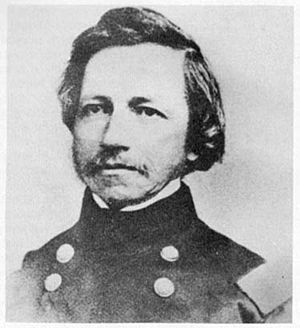Amiel Weeks Whipple facts for kids
Quick facts for kids
Amiel Weeks Whipple
|
|
|---|---|

Amiel Weeks Whipple
|
|
| Born | October 21, 1817 Greenwich, Massachusetts |
| Died | May 7, 1863 (aged 44) Washington, D.C. |
| Place of burial |
Proprietors' Cemetery, Portsmouth, New Hampshire
|
| Allegiance | United States of America Union |
| Service/ |
United States Army Union Army |
| Years of service | 1841–1863 |
| Rank | |
| Battles/wars | American Civil War |
Amiel Weeks Whipple (born October 21, 1817 – died May 7, 1863) was an American army officer and a special engineer who mapped land. He became a brigadier general during the American Civil War. He was badly hurt in the Battle of Chancellorsville and later died from his wounds. Whipple helped map the new border between the United States and Mexico. He also led a team to find the best path for a railroad across America. This route went from Arkansas to Los Angeles.
Contents
Biography
Early Life and Education
Amiel Weeks Whipple was born in Greenwich, Massachusetts. His parents were David and Abigail Brown Whipple. He grew up in Concord, Massachusetts, where his father owned an inn. In 1834, he was teaching school in Concord. He applied to the United States Military Academy at West Point.
He was not accepted at first. So, he went to Amherst College. In 1837, he was finally accepted into West Point. Whipple graduated in 1841. He was the fifth best student in his class.
Mapping the Borders
Early in his career, Whipple worked on many mapping projects. He surveyed the Patapsco River. He also mapped the waters near New Orleans. He surveyed Portsmouth Harbor too. From 1844 to 1849, he helped map the northeastern border of the United States. He worked under James Duncan Graham.
In 1848, Whipple joined the U.S. Boundary Commission. Their job was to map the new border between the U.S. and Mexico. This new border was set after the Mexican–American War. For a while, he was the main surveyor. Later, William H. Emory took over this role.
The survey teams traveled east from San Diego. They went through very rough and remote land. It was extremely hot in the desert. They also faced challenges from Apache Indians. Whipple finished his surveys despite these problems. He was promoted to first lieutenant on April 24, 1851. By 1853, his mapping work was done. He had also written his reports.
Searching for a Railroad Route
In 1853, Congress decided to find the best route for a railroad across America. This was called the Pacific Railroad Surveys. Whipple was chosen to lead one of these surveys. His route would follow the 35th parallel. It would go from Fort Smith, Arkansas, to Los Angeles.
The Whipple expedition started on July 15, 1853. There were about seventy men in the group. This included soldiers, drivers, and scientists. Some scientists were John Milton Bigelow, a doctor and plant expert. Jules Marcou was a Swiss geologist. Balduin Möllhausen was a German artist.
Whipple's team made good progress. They went through Indian Territory (now Oklahoma). They also crossed the Texas panhandle and New Mexico. They reached Albuquerque on October 5. After Albuquerque, Antoine Leroux joined them. He was a frontiersman who helped guide them. He led them through the hardest part of the trip to California. They reached California on February 7. They had a tough time crossing the Colorado River. Then they crossed the Mojave Desert. They finally arrived in Los Angeles on March 20, 1854.
The findings from Whipple's trip were published. They were part of a huge twelve-volume report. It was called the Pacific Railroad Reports. The report included information on land, rocks, plants, and animals. Whipple also wrote a long essay. It was about the Native American tribes they met in the Southwest.
Civil War Service
In 1855, Whipple was promoted to captain. He then worked on making the Great Lakes better for large ships. He helped deepen channels in places like the St. Clair flats. He also commanded lighthouse districts. These stretched from Lake Superior to the Saint Lawrence River.
When the Civil War began, Whipple worked for General Irvin McDowell. He led a new unit that used balloons to spy. He even went up in a balloon over Confederate lines at Bull Run. Later, he became the chief engineer for General George B. McClellan. This was in the Army of the Potomac. Whipple's maps were used in many battles in Virginia.
In 1862, he became a brigadier general of volunteers. He led the defense of Washington, D.C. on the Virginia side. In September 1862, Whipple joined the Third Army Corps. He fought in the Battle of Fredericksburg in December.
Whipple was badly wounded by a sharpshooter. This happened at Chancellorsville on May 4, 1863. He was given last rites on the battlefield. Then he was taken to Washington. President Lincoln was a friend of Whipple's. Just before Whipple died on May 7, Lincoln promoted him. He became a major general of volunteers. Lincoln rode in Whipple's funeral procession. Whipple was later given more honors after his death. Both of his sons were given spots at military academies. He was buried in the Proprietors' Cemetery in Portsmouth, New Hampshire.
Commemoration
Two forts were named after Whipple to honor him. One was Fort Whipple in Arizona. The other was Fort Whipple in Arlington County, Virginia. This fort is now Fort Myer. In California, Whipple Peak was named for him. This was done by Joseph C. Ives. Ives was a surveyor who worked with Whipple. Later, the Whipple Mountains and the Whipple Mountains Wilderness were also named after him. Many plants were named in his honor too. These include the genus Whipplea and the species Hesperoyucca whipplei and Sclerocactus whipplei.
See Also

